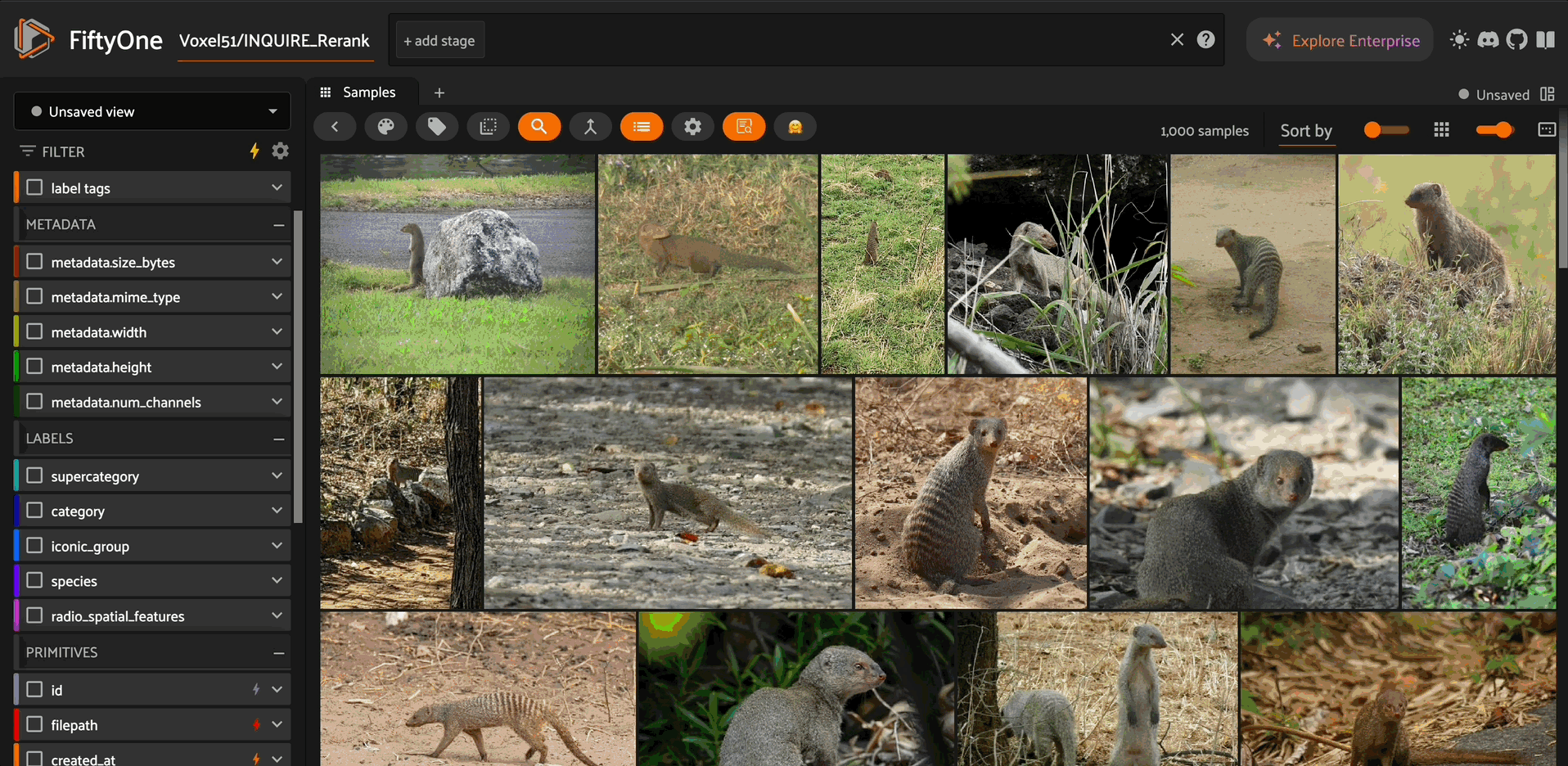Note
This is a community plugin, an external project maintained by its respective author. Community plugins are not part of FiftyOne core and may change independently. Please review each plugin’s documentation and license before use.
NVLabs C-RADIO Models for FiftyOne#

This repository provides FiftyOne integration for C-RADIO models from NVIDIA Labs. RADIO models are state-of-the-art models that produce rich spatial features and global summaries, making them excellent for image embeddings, similarity search, attention visualization, and downstream computer vision tasks.
Features#
Multiple Model Variants: Support for all RADIO model sizes (C-RADIOv3-B/L/H/g)
Dual Output Types: Extract global summary embeddings or spatial attention features
Attention Heatmaps: Visualize what regions the model focuses on
FiftyOne Integration: Seamless integration with FiftyOne’s computer vision workflows
GPU Acceleration: Optimized CUDA support with automatic mixed precision (bfloat16)
Production Ready: Robust error handling and device management
Installation#
# Install FiftyOne
pip install fiftyone
# Register the RADIO model source
import fiftyone.zoo as foz
foz.register_zoo_model_source(
"https://github.com/harpreetsahota204/NVLabs_CRADIOV3",
)
Quick Start#
import fiftyone as fo
import fiftyone.zoo as foz
# Load a dataset
dataset = foz.load_zoo_dataset("quickstart", shuffle=True)
# Load RADIO model for embeddings
model = foz.load_zoo_model("nv_labs/c-radio_v3-h")
# Compute embeddings
dataset.compute_embeddings(
model=model,
embeddings_field="radio_embeddings",
)
# Launch FiftyOne App
session = fo.launch_app(dataset)
Available Models#
Model Name |
Description |
Architecture |
Patch Size |
Best For |
|---|---|---|---|---|
|
C-RADIOv3-B |
ViT-B/16 |
16×16 |
Fast inference, moderate accuracy |
|
C-RADIOv3-L |
ViT-L/16 |
16×16 |
Balanced performance |
|
C-RADIOv3-H |
ViT-H/16 |
16×16 |
High accuracy, recommended |
|
C-RADIOv3-g |
ViT-H/14 |
14×14 |
Maximum performance |
Model Configuration#
Output Types#
# Global image embeddings (default)
model = foz.load_zoo_model(
"nv_labs/c-radio_v3-h",
output_type="summary" # Global semantic features
)
# Spatial attention features
spatial_model = foz.load_zoo_model(
"nv_labs/c-radio_v3-h",
output_type="spatial" # Patch-level spatial features
)
Feature Formats#
# returns a 1D embedding vector, dimensions 3048
model = foz.load_zoo_model(
"nv_labs/c-radio_v3-h",
output_type="summary",
feature_format="NCHW" # "NCHW": [Batch, Channels, Height, Width] , or you can use "NLC":[Batch, Num_patches, Channels]
)
# returns spatial features which are parsed as a FiftyOne Heatmap
model = foz.load_zoo_model(
"nv_labs/c-radio_v3-h",
output_type="spatial",
feature_format="NCHW" # can only use this format for spatial features
)
Complete Configuration Options#
model = foz.load_zoo_model(
"nv_labs/c-radio_v3-h",
# Core settings
output_type="spatial", # "summary" or "spatial"
feature_format="NCHW", # "NCHW" or "NLC" (NCHW only for spatial)
# Performance options
use_mixed_precision=True, # Auto-detected, bfloat16 on Ampere+
use_external_preprocessor=False, # Advanced preprocessing
# Spatial heatmap options (when output_type="spatial")
apply_smoothing=True, # Smooth attention heatmaps
smoothing_sigma=1.51, # Gaussian smoothing strength
)
Use Cases & Examples#
1. Global Image Embeddings#
Extract high-level semantic representations for similarity search and clustering:
# Compute embeddings
dataset.compute_embeddings(
model=model,
embeddings_field="radio_embeddings"
)
2. Spatial Attention Heatmaps#
Visualize what regions the model pays attention to:
# Load spatial model with smoothing
spatial_model = foz.load_zoo_model(
"nv_labs/c-radio_v3-h",
output_type="spatial",
apply_smoothing=True, # or False
smoothing_sigma=0.51, # used only when apply_smoothing=True
feature_format="NCHW"
)
# Generate attention heatmaps
dataset.apply_model(spatial_model, "radio_heatmap")
# View heatmaps in FiftyOne App
session = fo.launch_app(dataset)
3. Embedding Visualization with UMAP#
Create 2D visualizations of your image embeddings:
import fiftyone.brain as fob
# First compute embeddings
dataset.compute_embeddings(
model=model,
embeddings_field="radio_embeddings"
)
# Create UMAP visualization
results = fob.compute_visualization(
dataset,
method="umap", # Also supports "tsne", "pca"
brain_key="radio_viz",
embeddings="radio_embeddings"
)
# Explore in the App
session = fo.launch_app(dataset)
4. Similarity Search#
Build powerful similarity search with RADIO embeddings:
import fiftyone.brain as fob
# Build similarity index
results = fob.compute_similarity(
dataset,
backend="sklearn", # Fast sklearn backend
brain_key="radio_sim",
embeddings="radio_embeddings"
)
# Find similar images
sample_id = dataset.first().id
similar_samples = dataset.sort_by_similarity(
sample_id,
brain_key="radio_sim",
k=10 # Top 10 most similar
)
# View results
session = fo.launch_app(similar_samples)
5. Dataset Representativeness#
Score how representative each sample is of your dataset:
import fiftyone.brain as fob
# Compute representativeness scores
fob.compute_representativeness(
dataset,
representativeness_field="radio_represent",
method="cluster-center",
embeddings="radio_embeddings"
)
# Find most representative samples
representative_view = dataset.sort_by("radio_represent", reverse=True)
6. Duplicate Detection#
Find and remove near-duplicate images:
import fiftyone.brain as fob
# Detect duplicates using embeddings
results = fob.compute_uniqueness(
dataset,
embeddings="radio_embeddings"
)
# Filter to most unique samples
unique_view = dataset.sort_by("uniqueness", reverse=True)
7. Advanced: Custom Analysis Pipeline#
Combine multiple RADIO outputs for comprehensive analysis:
# Step 1: Global embeddings for similarity
embedding_model = foz.load_zoo_model("nv_labs/c-radio_v3-h")
dataset.compute_embeddings(embedding_model, "radio_embeddings")
# Step 2: Spatial heatmaps for attention analysis
spatial_model = foz.load_zoo_model(
"nv_labs/c-radio_v3-h",
output_type="spatial",
apply_smoothing=True,
smoothing_sigma=0.8
)
dataset.apply_model(spatial_model, "radio_heatmap")
# Step 3: Build similarity index
import fiftyone.brain as fob
fob.compute_similarity(dataset, embeddings="radio_embeddings", brain_key="radio_sim")
# Step 4: Comprehensive analysis
session = fo.launch_app(dataset)
Model Architecture Details#
RADIO Foundation Models#
Architecture: Vision Transformer with rich multi-scale feature extraction
Training: Large-scale self-supervised and multi-modal training
Capabilities: Both global semantic understanding and fine-grained spatial attention
Resolution: Adaptive resolution support with dynamic resizing
Feature Specifications#
Spatial Features: Rich channel features at multiple spatial scales
Preprocessing: Automatic RGB normalization to [0,1] range
Device Management: Automatic GPU/CPU placement with mixed precision support
Troubleshooting#
Common Issues#
GPU Memory Errors
# Use smaller models or disable mixed precision
model = foz.load_zoo_model(
"nv_labs/c-radio_v3-b", # Use smaller model
use_mixed_precision=False
)
Mixed Precision Issues
# Disable mixed precision on older GPUs
model = foz.load_zoo_model(
"nv_labs/c-radio_v3-h",
use_mixed_precision=False
)
Citation#
@misc{heinrich2025radiov25improvedbaselinesagglomerative,
title={RADIOv2.5: Improved Baselines for Agglomerative Vision Foundation Models},
author={Greg Heinrich and Mike Ranzinger and Hongxu and Yin and Yao Lu and Jan Kautz and Andrew Tao and Bryan Catanzaro and Pavlo Molchanov},
year={2024},
eprint={2412.07679},
archivePrefix={arXiv},
primaryClass={cs.CV},
url={https://arxiv.org/abs/2412.07679},
}
License#
This implementation follows the original RADIO model license. Please refer to the NVIDIA RADIO repository for complete license details.
Contributing#
Contributions are welcome! Please feel free to submit:
Bug reports and issues
Feature requests and suggestions
Pull requests with improvements
Documentation enhancements
